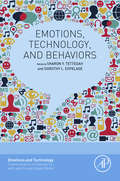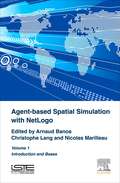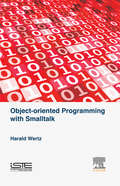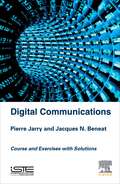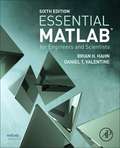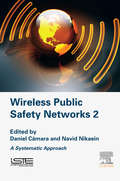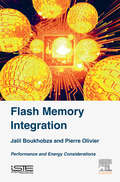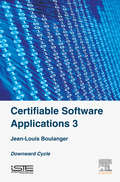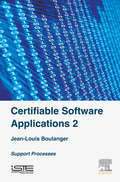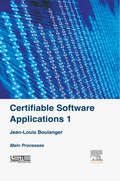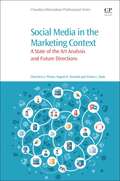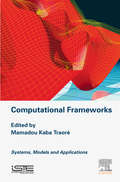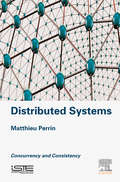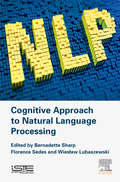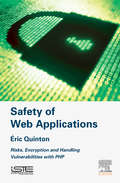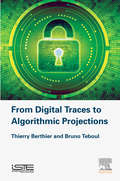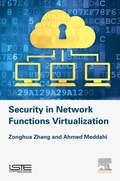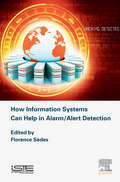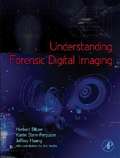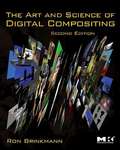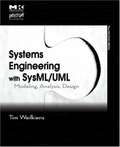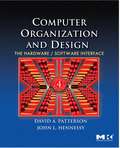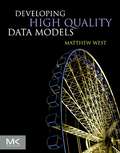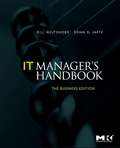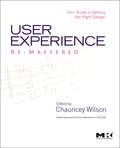- Table View
- List View
Emotions, Technology, and Behaviors (ISSN)
by Dorothy L. Espelage Sharon Y. TettegahExploring the connections between technology, emotions, and behaviors is increasingly important as we spend more and more time online and in digital environments. Technology, Emotions, and Behavior explains the role of technology in the evolution of both emotions and behaviors, and their interaction with each other. It discusses emotion modeling, distraction, and contagion as related to digital narrative and virtual spaces. It examines issues of trust and technology, behaviors used by individuals who are cut off from technology, and how individuals use technology to cope after disasters such as Hurricane Sandy. Technology, Emotions and Behaviors ends by exploring the construct of empathy and perspective-taking through online videos and socially shared activities. Practitioners and researchers will find this text useful in their work. Reviews the intersection between emotional contagion and emotional socialization theory in virtual interactionsExamines cross-cultural communicative feedbackDiscusses the multi-dimensions of trust in technologyCovers "digilante" rhetoric and its emotional appealDevotes an entire section to cyberbullying
Agent-Based Spatial Simulation with NetLogo Volume 1: Introduction And Bases
by Arnaud Banos Christophe Lang Nicolas MarilleauAgent-based modeling is a flexible and intuitive approach that is close to both data and theories, which gives it a special position in the majority of scientific communities. Agent models are as much tools of understanding, exploration and adaptation as they are media for interdisciplinary exchange. It is in this kind of framework that this book is situated, beginning with agent-based modeling of spatialized phenomena with a methodological and practical orientation. Through a governing example, taking inspiration from a real problem in epidemiology, this book proposes, with pedagogy and economy, a guide to good practices of agent modeling. The reader will thus be able to understand and put the modeling into practice and acquire a certain amount of autonomy.Featuring the following well-known techniques and tools: Modeling, such as UML, Simulation, such as the NetLogo platform, Exploration methods, Adaptation using participative simulation
Object-oriented Programming with Smalltalk
by Harald WertzObject oriented programming is a way of thinking about problems. Smalltalk is one of the purest incarnations of an object-oriented programming language. Using a pedagogical approach, this book covers all aspects of object oriented programming: first through the study of various preexisting Smalltalk classes, their implementation and use; then through a detailed description of an implementation of an interactive Lindenmayer system and through implementation of a series of calculators. The author addresses such subjects as graphics programming, dependency mechanisms and hierarchical specialization. This book fills the gap for an in-depth self-study reference, permitting the reader to master all aspects of object-oriented programming through a large set of exercises with highly detailed resources.Downloadable software content for practice applicationsCovers all aspects of Smalltalk: theconcepts of primitive objects, classes and instances, static and dynamic inheritance and methods, as well as graphical programming, the dependency mechanisms and the handling of exceptionsFeatures in-depth studies of two programming projects and annotated solutions to all exercies and appendices
Digital Communications: Courses and Exercises with Solutions
by Pierre Jarry Jacques N. BeneatDigital communications plays an important role in numerical transmission systems due to the proliferation of radio beams, satellite, optic fibbers, radar, and mobile wireless systems. This book provides the fundamentals and basic design techniques of digital communications with an emphasis on the systems of telecommunication and the principles of baseband transmission. With a focus on examples and exercises, this book will prepare you with a practical and real-life treatment of communication problems.A complete analysis of the structures used for emission or reception technologyA set of approaches for implementation in current and future circuit designA summary of the design steps with examples and exercises for each circuit
Essential Matlab For Engineers And Scientists (PDF)
by Brian Hahn Daniel T. ValentineEssential MATLAB for Engineers and Scientists, Sixth Edition, provides a concise, balanced overview of MATLAB's functionality that facilitates independent learning, with coverage of both the fundamentals and applications. The essentials of MATLAB are illustrated throughout, featuring complete coverage of the software's windows and menus. Program design and algorithm development are presented clearly and intuitively, along with many examples from a wide range of familiar scientific and engineering areas.
Wireless Public Safety Networks 2: A Systematic Approach
by Daniel Câmara Navid NikaeinWireless Public Safety Networks, Volume Two: A Systematic Approach presents the latest advances in the wireless Public Safety Networks (PSNs) field, the networks established by authorities to either prepare the population for an eminent catastrophe, or those used for support during crisis and normalization phases. Maintaining communication capabilities in a disaster scenario is crucial for avoiding loss of lives and damages to property. This book examines past communication failures that have directly contributed to the loss of lives, giving readers in-depth discussions of the public networks that impact emergency management, covering social media, crowdsourcing techniques, wearable wireless sensors, moving-cells scenarios, mobility management protocols, 5G networks, broadband networks, data dissemination, and the resources of the frequency spectrum. Provides a focus on specific enabling technologies which can help the most on the deployment and usage of PSNs in real world scenariosProposes a general framework that has the capability to fulfill the public safety requirements and dynamically adapt to different public safety situationsInvestigates the problem of data dissemination over PSNs, presenting a review of the state-of-the-art of different information and communication technologies
Flash Memory Integration: Performance and Energy Issues
by Jalil Boukhobza Pierre Olivier4 zettabytes (4 billion terabytes) of data generated in 2013, 44 zettabytes predicted for 2020 and 185 zettabytes for 2025. These figures are staggering and perfectly illustrate this new era of data deluge. Data has become a major economic and social challenge. The speed of processing of these data is the weakest link in a computer system: the storage system. It is therefore crucial to optimize this operation. During the last decade, storage systems have experienced a major revolution: the advent of flash memory. Flash Memory Integration: Performance and Energy Issues contributes to a better understanding of these revolutions. The authors offer us an insight into the integration of flash memory in computer systems, their behavior in performance and in power consumption compared to traditional storage systems. The book also presents, in their entirety, various methods for measuring the performance and energy consumption of storage systems for embedded as well as desktop/server computer systems. We are invited on a journey to the memories of the future. Ideal for computer scientists, featuring low level details to concentrate on system issuesTackles flash memory aspects while spanning domains such as embedded systems and HPCContains an exhaustive set of experimental results conducted in the Lab-STICC laboratoryProvides details on methodologies to perform performance and energy measurements on flash storage systems
Certifiable Software Applications 3: Downward Cycle
by Jean-Louis BoulangerCertifiable Software Applications 3: Downward Cycle describes the descending phase of the creation of a software application, detailing specification phases, architecture, design and coding, and important concepts on modeling and implementation. For coding, code generation and/or manual code production strategies are explored. As applications are coded, a presentation of programming languages and their impact on certifiability is included.Describes the descending phase of the creation of a software application, detailing specification phases, architecture, design and codingPresents valuable programming examplesIncludes a presentation of programming languages and their impact on certifiability
Certifiable Software Applications 2: Support Processes
by Jean-Louis BoulangerCertifiable Software Applications 2: Support Processes explains the process to achieve a certifiable application. This concerns several major topics, skill management, data preparation, requirement management, software verification, and software validation. In addition, analysis of the impact of the use of COTS and pre-existing software on certifiable software is presented. Finally, the last support process concerns the management of commercial tools, the creation of a specific tools, and therefore the qualification of tools, which is based on their impact on the final software.Explains configuration management, management of anomalies, skills management, and quality controlDiscusses the major topics of skill management, data preparation, requirement management, software verification, and software validationPresents tactics for the management of commercial tools and the creation of a specific tool which is based on their impact on the final software
Certifiable Software Applications 1: Main Processes
by Jean-Louis BoulangerCertifiable Software Applications 1: Main Processes is dedicated to the establishment of quality assurance and safety assurance. It establishes the context for achieving a certifiable software application. In it, the author covers recent developments such as the module, component and product line approach. Applicable standards are presented and security principles are described and discussed. Finally, the requirements for mastering quality and configuration are explained. In this book the reader will find the fundamental practices from the field and an introduction to the concept of software application.Presents the fundamental practices from the fieldEmphasizes the development of quality assurance and safety assuranceIntroduces the concept of software applicationCovers recent developments such as module, component, and the product line approach
SOCIAL MEDIA IN THE MARKETING CONTEXT: A State of the Art Analysis and Future Directions (pdf)
by Geoff Walton Woody Evans Cherniece J. Plume Yogesh K. Dwivedi Emma L. Slade9780081017548
Computational Frameworks: Systems, Models and Applications
by Mamadou Kaba TraoreComputational Frameworks: Systems, Models and Applications provides an overview of advanced perspectives that bridges the gap between frontline research and practical efforts. It is unique in showing the interdisciplinary nature of this area and the way in which it interacts with emerging technologies and techniques. As computational systems are a dominating part of daily lives and a required support for most of the engineering sciences, this book explores their usage (e.g. big data, high performance clusters, databases and information systems, integrated and embedded hardware/software components, smart devices, mobile and pervasive networks, cyber physical systems, etc.).Provides a unique presentation on the views of frontline researchers on computational systems theory and applications in one holistic scopeCover both computational science and engineering Bridges the gap between frontline research and practical efforts
Distributed Systems: Concurrency and Consistency
by Matthieu PerrinDistributed Systems: Concurrency and Consistency explores the gray area of distributed systems and draws a map of weak consistency criteria, identifying several families and demonstrating how these may be implemented into a programming language. Unlike their sequential counterparts, distributed systems are much more difficult to design, and are therefore prone to problems. On a large scale, usability reminiscent of sequential consistency, which would provide the same global view to all users, is very expensive or impossible to achieve. This book investigates the best ways to specify the objects that are still possible to implement in these systems.Explores the gray area of distributed systems and draws a map of weak consistency criteriaInvestigates the best ways to specify the objects that are still possible to implement in these systemsPresents a description of existing memory models and consistency criteria
Cognitive Approach to Natural Language Processing
by Florence Sedes Bernadette Sharp Wieslaw LubaszewskiAs natural language processing spans many different disciplines, it is sometimes difficult to understand the contributions and the challenges that each of them presents. This book explores the special relationship between natural language processing and cognitive science, and the contribution of computer science to these two fields. It is based on the recent research papers submitted at the international workshops of Natural Language and Cognitive Science (NLPCS) which was launched in 2004 in an effort to bring together natural language researchers, computer scientists, and cognitive and linguistic scientists to collaborate together and advance research in natural language processing. The chapters cover areas related to language understanding, language generation, word association, word sense disambiguation, word predictability, text production and authorship attribution. This book will be relevant to students and researchers interested in the interdisciplinary nature of language processing. Discusses the problems and issues that researchers face, providing an opportunity for developers of NLP systems to learn from cognitive scientists, cognitive linguistics and neurolinguisticsProvides a valuable opportunity to link the study of natural language processing to the understanding of the cognitive processes of the brain
Safety of Web Applications: Risks, Encryption and Handling Vulnerabilities with PHP
by Eric QuintonSafety of Web Applications: Risks, Encryption and Handling Vulnerabilities with PHP explores many areas that can help computer science students and developers integrate security into their applications. The Internet is not secure, but it's very friendly as a tool for storing and manipulating data. Customer confidence in Internet software is based on it's ability to prevent damage and attacks, but secure software is complicated, depending on several factors, including good risk estimation, good code architecture, cyphering, web server configuration, coding to prevent the most common attacks, and identification and rights allocation.Helps computer science students and developers integrate security into their applicationsIncludes sections on risk estimate, MVC modeling, the cyphering (certificates, bi-keys, https protocol)
From Digital Traces to Algorithmic Projections
by Thierry Berthier Bruno TeboulFrom Digital Traces to Algorithmic Projections describes individual digital fingerprints in interaction with the different algorithms they encounter throughout life. Centered on the human user, this formalism makes it possible to distinguish the voluntary projections of an individual and their systemic projections (suffered, metadata), both open (public) and closed. As the global algorithmic projection of an individual is now the focus of attention (Big Data, neuromarketing, targeted advertising, sentiment analysis, cybermonitoring, etc.) and is used to define new concepts, this resource discusses the ubiquity of place and the algorithmic consent of a user.Proposes a new approachDescribes an individual's fingerprintFocuses on the human userDefines the new concepts
Security in Network Functions Virtualization
by Zonghua Zhang Ahmed MeddahiThe software and networking industry is experiencing a rapid development and deployment of Network Functions Visualization (NFV) technology, in both enterprise and cloud data center networks. One of the primary reasons for this technological trend is that NFV has the capability to reduce CAPEX and OPEX, whilst increasing networking service efficiency, performance, agility, scalability, and resource utilization. Despite such well-recognized benefits, security remains a major concern of network service providers and seriously impedes the further expansion of NFV. This book is therefore dedicated to investigating and exploring the potential security issues of NFV. It contains three major elements: a thorough overview of the NFV framework and architecture, a comprehensive threat analysis aiming to establish a layer-specific threat taxonomy for NFV enabled networking services, and a series of comparative studies of security best practices in traditional networking scenarios and in NFV, ultimately leading to a set of recommendations on security countermeasures in NFV. This book is primarily intended for engineers, engineering students and researchers and those with an interest in the field of networks and telecommunications (architectures, protocols, services) in general, and particularly software-defined network (SDN) and network functions virtualization (NFV)-based security services. Extensively studies security issues in NFVPresents a basis or guideline for both academia researchers and industry practitioners to work together to achieve secure and dependable lifecycle management of NFV based network services
How Information Systems Can Help in Alarm/Alert Detection
by Florence SedesAlarm or alert detection remains an issue in various areas from nature, i.e. flooding, animals or earthquake, to software systems. Liveness, dynamicity, reactivity of alarm systems: how to ensure the warning information reach the right destination at the right moment and in the right location, still being relevant for the recipient, in spite of the various and successive filters of confidentiality, privacy, firewall policies, etc.? Also relevant in this context are to technical contingency issues: material failure, defect of connection, break of channels, independence of information routes and sources? Alarms with crowd media, (mis)information vs. rumours: how to make the distinction? The prediction of natural disasters (floods, avalanches, etc.), health surveillance (affectionate fevers of cattle, pollution by pesticides, etc.), air, sea and land transport, or space surveillance to prevent Risks of collisions between orbital objects involve more and more actors within Information Systems, one of whose purposes is the dissemination of alerts. By expanding the capabilities and functionality of such national or international systems, social networks are playing a growing role in dissemination and sharing, eg. with the support of systems like the Google Alert (https://www.google.fr/alerts) which concerns the publication of contents online. Recently, the Twitter microblogging platform announced a broadcast service, designed to help government organizations with alerts to the public. The proper functioning of such systems depends on fundamental properties such as resilience, liveliness and responsiveness: any alert must absolutely reach the right recipient at the right time and in the right place, while remaining relevant to him, despite the various constraints. on the one hand to external events, such as hardware failures, connection faults, breaks in communication channels, on the other hand to confidentiality, such as the collection and use of personal data (with or without the consent of the user), or the disparity of access policies (generation according to industrial, technological, security constraints, management of internal / external policies, etc.) between actors. This book opens the discussion on the "procrastination", the dynamics and the reactivity of the alert systems, but also the problems of confidentiality, filtering of information, and the means of distinguishing information and rumor. Presents alarm or alert detection in all its aspectsFinds a solution so that the alert information reaches the right destinationFind relevance to various technical issues
Understanding Forensic Digital Imaging (PDF)
by Herbert L. Blitzer Karen Stein-Ferguson Jeffrey HuangUnderstanding Forensic Digital Imaging offers the principles of forensic digital imaging and photography in a manner that is straightforward and easy to digest for the professional and student. It provides information on how to photograph any setting that may have forensic value, details how to follow practices that are acceptable in court, and recommends what variety of hardware and software are most valuable to a practitioner. In addition to chapters on basic topics such as light and lenses, resolution, and file formats, the book contains forensic-science-specific information on SWGIT and the use of photography in investigations and in court. Of particular note is Chapter 17, Establishing Quality Requirements, which offers information on how to create a good digital image, and is more comprehensive than any other source currently available. Covers topics that are of vital importance to the practicing professional Serves as an up-to-date reference in the rapidly evolving world of digital imaging Uses clear and concise language so that any reader can understand the technology and science behind digital imaging
The Art and Science of Digital Compositing: Techniques for Visual Effects, Animation and Motion Graphics (PDF)
by Ron BrinkmannThe classic reference, with over 25,000 copies in print, has been massively expanded and thoroughly updated to include state-of-the-art methods and 400+ all-new full color images! "At ILM, compositing is one of the most important tools we use. If you want to learn more, this excellent 2nd-edition is detailed with hundreds of secrets that will help make your comps seamless. For beginners or experts, Ron walks you through the processes of analysis and workflows - linear thinking which will help you become deft and successfully tackle any shot. " --Dennis Muren ASC, Senior Visual Effects Supervisor, Industrial Light & Magic "Ron Brinkman's book is the definitive work on digital compositing and we have depended on this book as a critical part of our in-house training program at Imageworks since the 1999 Edition. We use this book as a daily textbook and reference for our lighters, compositors and anyone working with digital imagery. It is wonderful to see a new edition being released and it will certainly be required reading for all our digital artists here at Imageworks. " --Sande Scoredos, Executive Director of Training & Artist Development, Sony Pictures Imageworks The Art and Science of Digital Compositing is the only complete overview of the technical and artistic nature of digital compositing. It covers a wide range of topics from basic image creation, representation and manipulation, to a look at the visual cues that are necessary to create a believable composite. Designed as an introduction to the field, as well as an authoritative technical reference, this book provides essential information for novices and professionals alike. 17 new case-studies provide in-depth looks at the compositing work done on films such as Chronicles of Narnia: The Lion, the Witch and the Wardrobe, The Golden Compass, The Incredibles, King Kong, The Lord of the Rings: The Return of the King, Sin City, Spider-Man 2, Wallace and Gromit: The Curse of the Were-Rabbit, and Star Wars: Episode 3 - Revenge of the Sith. Includes new sections on 3D compositing, High Dynamic Range (HDR) imaging, Rotoscoping, and much more! All disc-based content for this title is now available on the Web. 17 new case-studies provide in-depth looks at the compositing work done on films such as Chronicles of Narnia: The Lion, the Witch and the Wardrobe, The Golden Compass, The Incredibles, King Kong, The Lord of the Rings: The Return of the King, Sin City, Spider-Man 2, Wallace and Gromit: The Curse of the Were-Rabbit, and Star Wars: Episode 3 - Revenge of the Sith. Includes new sections on 3D compositing, High Dynamic Range (HDR) imaging, Rotoscoping, and much more!
Systems Engineering With Sysml/uml: Modeling, Analysis, Design (The\omg Press Ser. (PDF))
by Tim WeilkiensUML, the Universal Modeling Language, was the first programming language designed to fulfill the requirement for "universality." However, it is a software-specific language, and does not support the needs of engineers designing from the broader systems-based perspective. Therefore, SysML was created. It has been steadily gaining popularity, and many companies, especially in the heavily-regulated Defense, Automotive, Aerospace, Medical Device and Telecomms industries, are already using SysML, or are plannning to switch over to it in the near future. However, little information is currently available on the market regarding SysML. Its use is just on the crest of becoming a widespread phenomenon, and so thousands of software engineers are now beginning to look for training and resources. This book will serve as the one-stop, definitive guide that provide an introduction to SysML, and instruction on how to implement it, for all these new users.
Computer Organization And Design: The Hardware/software Interface (PDF)
by David A. Patterson John L. HennessyThe best-selling computer organization book is thoroughly updated to provide a new focus on the revolutionary change taking place in industry today: the switch from uniprocessor to multicore microprocessors. This new emphasis on parallelism is supported by updates reflecting the newest technologies, with examples highlighting the latest processor designs and benchmarking standards. As with previous editions, a MIPS processor is the core used to present the fundamentals of hardware technologies, assembly language, computer arithmetic, pipelining, memory hierarchies and I/O. Sections on the ARM and x86 architectures are also included. Covers the revolutionary change from sequential to parallel computing, with a new chapter on parallelism and sections in every chapter highlighting parallel hardware and software topics. Includes a new appendix by the Chief Scientist and the Director of Architecture of NVIDIA covering the emergence and importance of the modern GPU, describing in detail for the first time the highly parallel, highly multithreaded multiprocessor optimized for visual computing. Describes a novel approach to measuring multicore performance--the "Roofline model"--with benchmarks and analysis for the AMD Opteron X4, Intel Xeon 5000, Sun UltraSPARC T2, and IBM Cell. Includes new content on Flash memory and Virtual Machines. Provides a large, stimulating set of new exercises, covering almost 200 pages. Features the AMD Opteron X4 and Intel Nehalem as real-world examples throughout the book. Updates all processor performance examples using the SPEC CPU2006 suite.
Developing High Quality Data Models
by Matthew WestDeveloping High Quality Data Models provides an introduction to the key principles of data modeling. It explains the purpose of data models in both developing an Enterprise Architecture and in supporting Information Quality; common problems in data model development; and how to develop high quality data models, in particular conceptual, integration, and enterprise data models. The book is organized into four parts. Part 1 provides an overview of data models and data modeling including the basics of data model notation; types and uses of data models; and the place of data models in enterprise architecture. Part 2 introduces some general principles for data models, including principles for developing ontologically based data models; and applications of the principles for attributes, relationship types, and entity types. Part 3 presents an ontological framework for developing consistent data models. Part 4 provides the full data model that has been in development throughout the book. The model was created using Jotne EPM Technologys EDMVisualExpress data modeling tool. This book was designed for all types of modelers: from those who understand data modeling basics but are just starting to learn about data modeling in practice, through to experienced data modelers seeking to expand their knowledge and skills and solve some of the more challenging problems of data modeling.Uses a number of common data model patterns to explain how to develop data models over a wide scope in a way that is consistent and of high quality Offers generic data model templates that are reusable in many applications and are fundamental for developing more specific templatesDevelops ideas for creating consistent approaches to high quality data models
IT Manager's Handbook: The Business Edition
by Bill Holtsnider Brian D. JaffeIT Manager’s Handbook: The Business Edition is a MUST-HAVE guide for the advancing technology professional who is looking to move up into a supervisory role, and is ideal for newly-promoted IT managers who needs to quickly understand their positions. It uses IT–related examples to discuss business topics and recognizes the ever-changing and growing demands of IT in today’s world as well as how these demands impact those who work in the field. Specific attention is paid to the latest issues, including the challenges of dealing with a mobile and virtual workforce, managing Gen-X/Yers, and running an IT organization in a troubled economy. Rich with external references and written in-easy-to-read sections, IT Manager’s Handbook: The Business Edition is the definitive manual to managing an IT department in today’s corporate environment.Focuses on Web 2.0 ideas and how they impact and play into today's organizations, so you can keep up on social networking, YouTube, web conferencing, instant messaging, Twitter, RSS Feeds, and other collaboration tools.Provides strategies on how to get employees to focus in the 24/7 data word.Discusses key IT topics in 'layman's terms' for business personnel who need to understand IT topics.
User Experience Re-Mastered: Your Guide to Getting the Right Design
by Chauncey WilsonUser Experience Re-Mastered: Your Guide to Getting the Right Design provides an understanding of key design and development processes aimed at enhancing the user experience of websites and web applications. The book is organized into four parts. Part 1 deals with the concept of usability, covering user needs analysis and card sorting—a tool for shaping information architecture in websites and software applications. Part 2 focuses on idea generation processes, including brainstorming; sketching; persona development; and the use of prototypes to validate and extract assumptions and requirements that exist among the product team. Part 3 presents core design principles and guidelines for website creation, along with tips and examples on how to apply these principles and guidelines. Part 4 on evaluation and analysis discusses the roles, procedures, and documents needed for an evaluation session; guidelines for planning and conducting a usability test; the analysis and interpretation of data from evaluation sessions; and user interface inspection using heuristic evaluation and other inspection methods.*A guided, hands-on tour through the process of creating the ultimate user experience – from testing, to prototyping, to design, to evaluation *Provides tried and tested material from best sellers in Morgan Kaufmann’s Series in Interactive Technologies, including leaders in the field such as Bill Buxton and Jakob Nielsen *Features never before seen material from Chauncey Wilson’s forthcoming, and highly anticipated Handbook for User Centered Design
